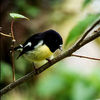Genus Petroica

New Zealand Robin - The male's plumage is a dark slate grey whereas the female is dark grey-brown. On both birds the throat and belly are considerably lighter, in the male a cream colour. It is this bright breast that gave the birds their name, in comparison with the bright breast of the European Robin. The birds generally inhabit the forest fringe, and can often be found in the green belts of towns and cities.
Alpine Robin - Its natural habitat is subtropical or tropical moist montanes.
Red-capped Robin - The position of the Red-capped Robin and its Australian relatives on the passerine family tree is unclear; the Petroicidae are not closely related to either the European or American Robins but appear to be an early offshoot of the Passerida group of songbirds. The Red-capped Robin is a predominantly ground-feeding bird and its prey consists of insects and spiders. Although widespread, it is uncommon in much of its range and has receded in some areas from human activity.
Tomtit - The Tomtit is one of four species of the genus Petroica found in New Zealand, the ancestors of which having colonised from Australia. The species was once thought to have been descended from the Scarlet Robin,
Scarlet Robin - The Pacific Robin is a small passerine, 11.5–13.5 cm long and weighing 9–11 g. Over much of its range it is the smallest species of bird. The plumage of the males and females is dimorphic, and the extent of this varies depending on the subspecies. The male of the nominate race has a black head with a white forehead, a black back and tail, and the wings are also black with a white bar. The breast an belly are red, and the lower belly and rump are white. The female lacks the white forehead and the white bar on the wing; and the black plumage of the male is replaced by dark brown feathers instead. The breast is a duller red than the male and has more brown on the sides, and the white on the rump also smaller. Both sexes have black legs and bills. Amongst the subspecies, some males have more female-like plumage, for example P. m. femenina of central Vanuatu; in others the female more closely resembles the male. The males of P. m. polymorpha of Makira in the Solomon Islands have two different plumage morphs, inclu
Flame Robin - The position of the Flame Robin and its Australian relatives on the passerine family tree is unclear; the Petroicidae are not closely related to either the European or American Robins but appear to be an early offshoot of the Passerida group of songbirds. The Flame Robin is a predominantly insectivorous, pouncing on prey from a perch in a tree, or foraging on the ground.
Pink Robin - Its natural habitats are temperate forests and subtropical or tropical moist lowland forests.
Rose Robin - It is endemic to Australia east or south of the Great Dividing Range, from Queensland through to southeastern South Australia. Its natural habitats are the gullies and valleys of temperate forests and subtropical or tropical moist lowland forests.
Chatham Robin - There are now around 250 black robins but in 1980 only five survived on Little Mangere Island. They were saved from extinction by Don Merton and his Wildlife Service team, and by "Old Blue", the last remaining fertile female. The remaining birds were moved to Mangere Island. They increased the annual output of Old Blue by removing the first clutch over every year and placing the eggs in the nest of the Chatham race of the Tomtit, a technique known as cross-fostering. The Tomtits raised the first brood, and the Black Robins, having lost their eggs, relaid and raised another brood.





